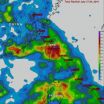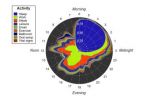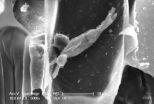Vanderbilt study examines bacteria's ability to fight obesity
2014-07-25
A probiotic that prevents obesity could be on the horizon. Bacteria that produce a therapeutic compound in the gut inhibit weight gain, insulin resistance and other adverse effects of a high-fat diet in mice, Vanderbilt University investigators have discovered.
"Of course it's hard to speculate from mouse to human," said senior investigator Sean Davies, Ph.D., assistant professor of Pharmacology. "But essentially, we've prevented most of the negative consequences of obesity in mice, even though they're eating a high-fat diet."
Regulatory issues must be addressed before ...
NSU researcher part of team studying ways to better predict intensity of hurricanes
2014-07-25
FORT LAUDERDALE-DAVIE, Fla. – They are something we take very seriously in Florida – hurricanes. The names roll off the tongue like a list of villains – Andrew, Charlie, Frances and Wilma.
In the past 25 years or so, experts have gradually been improving prediction of the course a storm may take. This is thanks to tremendous advancements in computer and satellite technology. While we still have the "cone of uncertainty" we've become familiar with watching television weather reports, today's models are more accurate than they used to be.
The one area, however, where ...
NASA maps Typhoon Matmo's Taiwan deluge
2014-07-25
When Typhoon Matmo crossed over the island nation of Taiwan it left tremendous amounts of rainfall in its wake. NASA used data from the TRMM satellite to calculate just how much rain fell over the nation.
The Tropical Rainfall Measuring Mission or TRMM satellite orbits the Earth and provides coverage over the tropics. TRMM is a satellite that is managed by both NASA and the Japan Aerospace Exploration Agency (JAXA) that acts as a "flying rain gauge in space," that can estimate how fast rain is falling within storms on Earth and how much rain has fallen.
On July 22, ...
Shift work linked to heightened risk of type 2 diabetes
2014-07-25
Shift work is linked to a heightened risk of developing type 2 diabetes, with the risk seemingly greatest among men and those working rotating shift patterns, indicates an analysis of the available evidence published online in Occupational & Environmental Medicine.
Previous research has suggested links between working shifts and a heightened risk of various health problems, including digestive disorders, certain cancers, and cardiovascular disease. But whether diabetes can be added to the list has not been clear.
The authors therefore trawled through scientific research ...
Smartphone experiment tracks whether our life story is written in our gut bacteria
2014-07-25
Life events such as visiting another country or contracting a disease cause a significant shift in the make-up of the gut microbiota – the community of bacteria living in the digestive system, according to research published in the open access journal Genome Biology.
Two participants used smartphone apps to collect information every day for a year in the study by scientists from MIT and Harvard. The authors think the method could be rolled out to studies of human-bacteria relationships with many more participants.
Our microbiota is the community of bacteria that share ...
Leaf-mining insects destroyed with the dinosaurs, others quickly appeared
2014-07-25
After the asteroid impact at the end of the Cretaceous period that triggered the dinosaurs' extinction and ushered in the Paleocene, leaf-mining insects in the western United States completely disappeared. Only a million years later, at Mexican Hat, in southeastern Montana, fossil leaves show diverse leaf-mining traces from new insects that were not present during the Cretaceous, according to paleontologists.
"Our results indicate both that leaf-mining diversity at Mexican Hat is even higher than previously recognized, and equally importantly, that none of the Mexican ...
Monitoring the rise and fall of the microbiome
2014-07-25
CAMBRIDGE, MA -- Trillions of bacteria live in each person's digestive tract. Scientists believe that some of these bacteria help digest food and stave off harmful infections, but their role in human health is not well understood.
To help shed light on the role of these bacteria, a team of researchers led by MIT associate professor Eric Alm recently tracked fluctuations in the bacterial populations of two research subjects over a full year. The findings, described in the July 25 issue of the journal Genome Biology, suggest that while these populations are fairly stable, ...
Atomic structure of key muscle component revealed in Penn study
2014-07-25
VIDEO:
This is a representation of the atomic structure of tropomodulin at the minus end of the actin filament in muscle sarcomeres. Tropomodulin interacts with the first three actin subunits of...
Click here for more information.
PHILADELPHIA - Actin is the most abundant protein in the body, and when you look more closely at its fundamental role in life, it's easy to see why. It is the basis of most movement in the body, and all cells and components within them have the capacity ...
Increased risk for head, neck cancers in patients with diabetes
2014-07-25
Diabetes mellitus (DM) appears to increase the risk for head and neck cancer (HNC). Evidence suggests certain cancers are more common in people with DM, but the risk of HNC in patients with DM has not been well explored. Overall, head and neck cancer is the sixth most common type of cancer. It accounts for about 6 percent of all cases and for an estimated 650,000 new cancer cases and 350,000 cancer deaths worldwide each year.
The authors used Taiwan's Longitudinal Health Insurance Research Database to examine the risk of HNC in patients with DM. The authors compared 89,089 ...
8.2 percent of our DNA is 'functional'
2014-07-25
Only 8.2% of human DNA is likely to be doing something important – is 'functional' – say Oxford University researchers.
This figure is very different from one given in 2012, when some scientists involved in the ENCODE (Encyclopedia of DNA Elements) project stated that 80% of our genome has some biochemical function.
That claim has been controversial, with many in the field arguing that the biochemical definition of 'function' was too broad – that just because an activity on DNA occurs, it does not necessarily have a consequence; for functionality you need to demonstrate ...
Invertebrate numbers nearly halve as human population doubles
2014-07-25
Invertebrate numbers have decreased by 45% on average over a 35 year period in which the human population doubled, reports a study on the impact of humans on declining animal numbers. This decline matters because of the enormous benefits invertebrates such as insects, spiders, crustaceans, slugs and worms bring to our day-to-day lives, including pollination and pest control for crops, decomposition for nutrient cycling, water filtration and human health.
The study, published in Science and led by UCL, Stanford and UCSB, focused on the demise of invertebrates in particular, ...
Farmers market vouchers may boost produce consumption in low-income families
2014-07-25
Vouchers to buy fresh fruits and vegetables at farmers markets increase the amount of produce in the diets of some families on food assistance, according to research led by NYU's Steinhardt School of Culture, Education, and Human Development.
The study, which appears online in Food Policy, suggests that farmers market vouchers can be useful tools in improving access to healthy food. This finding validates a new program created by the Agricultural Act of 2014, or farm bill, that incentivizes low-income families to buy produce at farmers markets.
"In terms of healthy ...
Researchers discover new way to determine cancer risk of chemicals
2014-07-25
BOSTON -- A new study has shown that it is possible to predict long-term cancer risk from a chemical exposure by measuring the short-term effects of that same exposure. The findings, which currently appear in the journal PLOS ONE, will make it possible to develop simpler and cheaper tests to screen chemicals for their potential cancer causing risk.
Despite an overall decrease in incidence of and mortality from cancer, about 40 percent of Americans will be diagnosed with the disease in their lifetime, and around 20 percent will die of it. Currently fewer than two percent ...
Less than 1 percent of UK public research funding spent on antibiotic research in past 5 years
2014-07-25
Less than 1% of research funding awarded by public and charitable bodies to UK researchers in 2008 was awarded for research on antibiotics, according to new research published in The Lancet Infectious Diseases.
The study, which is the first detailed assessment of public and charitable funding to UK researchers focusing on bacteriology and antibiotic research, suggests that present levels of funding for antibiotic research in the UK are inadequate, and will need to be urgently increased if the growing crisis of antibiotic resistance is to be tackled effectively by UK ...
Synchronization of North Atlantic, North Pacific preceded abrupt warming, end of ice age
2014-07-25
CORVALLIS, Ore. -- Scientists have long been concerned that global warming may push Earth's climate system across a "tipping point," where rapid melting of ice and further warming may become irreversible -- a hotly debated scenario with an unclear picture of what this point of no return may look like.
A newly published study by researchers at Oregon State University probed the geologic past to understand mechanisms of abrupt climate change. The study pinpoints the emergence of synchronized climate variability in the North Pacific Ocean and the North Atlantic Ocean a few ...
A world first: Researchers identify a treatment that prevents tumor metastasis
2014-07-25
Metastasis, the strategy adopted by tumor cells to transform into an aggressive form of cancer, are often associated with a gloomy prognosis. Managing to block the metastasis or, even better, prevent their formation would be a giant step towards the fight against cancer. Researchers at Université catholique de Louvain (Belgium) successfully performed this world first on models of human tumors in mice. The results of their study are published online on 24 July in the prestigious journal Cell Reports.
The work by Professor Pierre Sonveaux's team, at Université catholique ...
Noise pollution impacts fish species differently
2014-07-25
Acoustic disturbance has different effects on different species of fish, according to a new study from the Universities of Bristol and Exeter which tested fish anti-predator behaviour.
Three-spined sticklebacks responded sooner to a flying seagull predator model when exposed to additional noise, whereas no effects were observed in European minnows.
Lead author Dr Irene Voellmy of Bristol's School of Biological Sciences said: "Noise levels in many aquatic environments have increased substantially during the last few decades, often due to increased shipping traffic. ...
Four-billion-year-old chemistry in cells today
2014-07-25
Parts of the primordial soup in which life arose have been maintained in our cells today according to scientists at the University of East Anglia.
Research published today in the Journal of Biological Chemistry reveals how cells in plants, yeast and very likely also in animals still perform ancient reactions thought to have been responsible for the origin of life – some four billion years ago.
The primordial soup theory suggests that life began in a pond or ocean as a result of the combination of metals, gases from the atmosphere and some form of energy, such as a lightning ...
Corn and soy insecticides similar to nicotine found widespread in Midwest rivers -- USGS news
2014-07-25
Insecticides similar to nicotine, known as neonicotinoids, were found commonly in streams throughout the Midwest, according to a new USGS study. This is the first broad-scale investigation of neonicotinoid insecticides in the Midwestern United States and one of the first conducted within the United States.
Effective in killing a broad range of insect pests, use of neonicotinoid insecticides has dramatically increased over the last decade across the United States, particularly in the Midwest. The use of clothianidin, one of the chemicals studied, on corn in Iowa alone ...
Zerenex (ferric citrate) long-term Phase 3 study results published in JASN
2014-07-25
New York, NY - July 24, 2014 -- Keryx Biopharmaceuticals, Inc. (Nasdaq:KERX) (the "Company") announced the publication of results from the long-term, randomized, active control Phase 3 study of Zerenex (ferric citrate), the Company's investigational oral ferric iron-based phosphate binder, for the treatment of hyperphosphatemia in patients with end-stage renal disease (ESRD) on dialysis. The PERFECTED study (PhosphatE binding and iRon delivery with FErric CiTrate in EsrD) was published online today in the Journal of the American Society of Nephrology (JASN).
This Phase ...
New hope for powdery mildew resistant barley
2014-07-25
New research at the University of Adelaide has opened the way for the development of new lines of barley with resistance to powdery mildew.
In Australia, annual barley production is second only to wheat with 7-8 million tonnes a year. Powdery mildew is one of the most important diseases of barley.
Senior Research Scientist Dr Alan Little and team have discovered the composition of special growths on the cell walls of barley plants that block the penetration of the fungus into the leaf.
The research, by the ARC Centre of Excellence in Plant Cell Walls in the University's ...
NRG1 isoforms could be an effective therapeutic candidate to promote peripheral nerve regeneration
2014-07-25
Neuregulin 1 (NRG1) is a pleiotropic factor characterized by the existence of numerous isoforms arising from alternative splicing of exons that confer to the protein deeply different characteristics. NRG1 plays an important role for both the myelination occurring during development and the different phases occurring after injury in the peripheral nerve: axon degeneration, axon regrowth, remyelination and target reinnervation
Researchers at the University of Western Australia have discovered that the soluble NRG1 upregulation observed in Schwann cells immediately after ...
Assessment on self-care ability of children with spina bifda
2014-07-25
Spina bifda (SB) is a complex congenital central nervous system disease that is caused by the incomplete closing of the neural tubes during the embryonic phase. Many patients have varying degrees of spasticity, urinary and fecal incontinence and neurocognitive retardation. Such problems decrease the patients' functional independence and their quality of life. Researchers at Ankara Physical Medicine and Rehabilitation Education and Research Hospital, Turkey investigate the functional performance in children with SB, using the Pediatric Evaluation of Disability Inventory ...
Neurologic recovery from corticospinal tract injury due to subfalcine herniation
2014-07-25
After development of diffusion tensor tractography (DTT), which is derived from diffusion tensor imaging (DTI), three-dimensional reconstruction and estimation for three motor tracts, such as the corticospinal tract, the rubrospinal tract, and the corticoreticular pathway became possible. The corticospinal tract is known to be a major neural tract for motor function in the human brain. Several studies have reported on injury of the corticospinal tract by transtentorial herniation. In addition, some studies have demonstrated recovery of a corticospinal tract injured by transtentorial ...
Bacteria manipulate salt to build shelters to hibernate
2014-07-25
For the first time, Spanish researchers have detected an unknown interaction between microorganisms and salt. When Escherichia coli cells are introduced into a droplet of salt water and is left to dry, bacteria manipulate the sodium chloride crystallisation to create biomineralogical biosaline 3D morphologically complex formations, where they hibernate. Afterwards, simply by rehydrating the material, bacteria are revived. The discovery was made by chance with a home microscope, but it made the cover of the Astrobiology journal and may help to find signs of life on other ...
[1] ... [3330]
[3331]
[3332]
[3333]
[3334]
[3335]
[3336]
[3337]
3338
[3339]
[3340]
[3341]
[3342]
[3343]
[3344]
[3345]
[3346]
... [8702]
Press-News.org - Free Press Release Distribution service.







